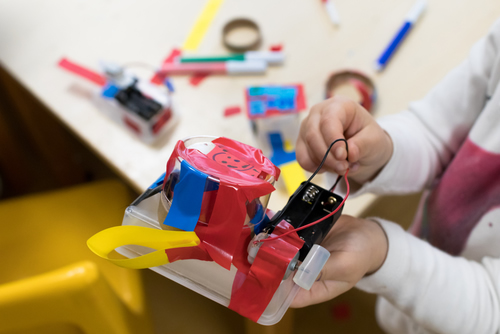More than half of today’s students will hold jobs that don’t yet exist today, which is why it is critically important for students to develop 21st-century skills such as creativity and problem solving.
STEAM learning can help schools ensure students are combining creativity with critical thinking and other key skills, and librarians are uniquely positioned to take an active role in designing STEAM programs and maker spaces.
Makerspaces, as outlined in a whitepaper from littleBits, can help expose students to STEAM as they develop essential skills for success after high school and college.
Maker education “often involves an interdisciplinary approach to instruction and learning: maker educators integrate visual arts, music, language arts, humanities, and social sciences into STEAM projects, giving students a chance to have a holistic experience with technology,” according to the paper.
What do maker spaces look like? Of schools that offer maker activities, most libraries (67 percent) have a dedicated space for maker-related activities—59 percent of those are in the school library. Roughly 32 percent of maker activities are tied directly to the curriculum. Schools looking to fit maker and STEAM education are typically offered during whole-class instruction (63 percent), and 48 percent of schools also offer these activities during students’ free periods.
The biggest obstacles to offering makerspaces are lack of funding (58 percent), lack of supplies (53 percent), and lack of time to offer such activities (37 percent).
A team of researchers worked with littleBits and School Library Journal to examine how school libraries are changing from hushed, disconnected places to interactive spaces where learning is engaging and innovative.
1. More than half (55 percent) of school libraries in the U.S. and Canada offer maker programs to students. Suburban schools (60 percent) are more likely to offer maker programs than urban (51 percent), rural (51 percent), or small-town (48 percent) schools.
2. Arts and crafts dominate the maker movement and are the most common offering in elementary and middle school makerspaces, according to 79 percent of respondents queried by researchers. Coding (58 percent), circuitry (45 percent), and robotics (31 percent) come in next.
3. Makerspace attendance is on the rise, and more than half of school librarians (57 percent) say maker attendance increased from the previous years. Middle schools and urban schools are most likely to report an increase in makerspace attendance.
4. Librarians want to be involved in school maker activities. Forty-one percent of librarians say they are very active in their school’s maker program, and 46 percent say they are somewhat involved.
5. Some schools have seen success combining maker activities with community service. Though just 8 percent of schools have managed this, middle schools (12 percent) and urban schools (10 percent) are most likely to do this.
6. Most librarians (92 percent) organize and run the majority of maker activities in schools.
7. Librarians say they are most interested in learning about robotics (51 percent), coding and programming (49 percent), animation (47 percent), video making and editing (46 percent), and 3D printing (44 percent).
The researchers also offer actionable strategies to help school leaders and teachers start STEAM programs in their own schools:
1. Policy makers and school administrators should align budgets with the demands of the future of work, students’ interest, and the potential for higher achievement.
2. Librarians and media specialists should have access to professional development resources so they can successfully lead innovation.
3. Staff meetings and school calendars should be designed in a way that lets librarians to interact more frequently with teachers. This will let them better integrate maker activities with curriculum and scale those activities beyond the library space.
4. Rethinking the design of school libraries will allow STEM and maker integration, collaboration between students, and opportunities for knowledge sharing.
5. Aligning maker activities with community causes gives students the opportunity to become more active citizens and make more meaningful connections between what they do and the needs of the community.
- Friday 5: College and career readiness - April 12, 2024
- Cybersecurity: eSN Innovation Roundtable - April 11, 2024
- School-home communication remains a challenge for many districts - April 10, 2024

